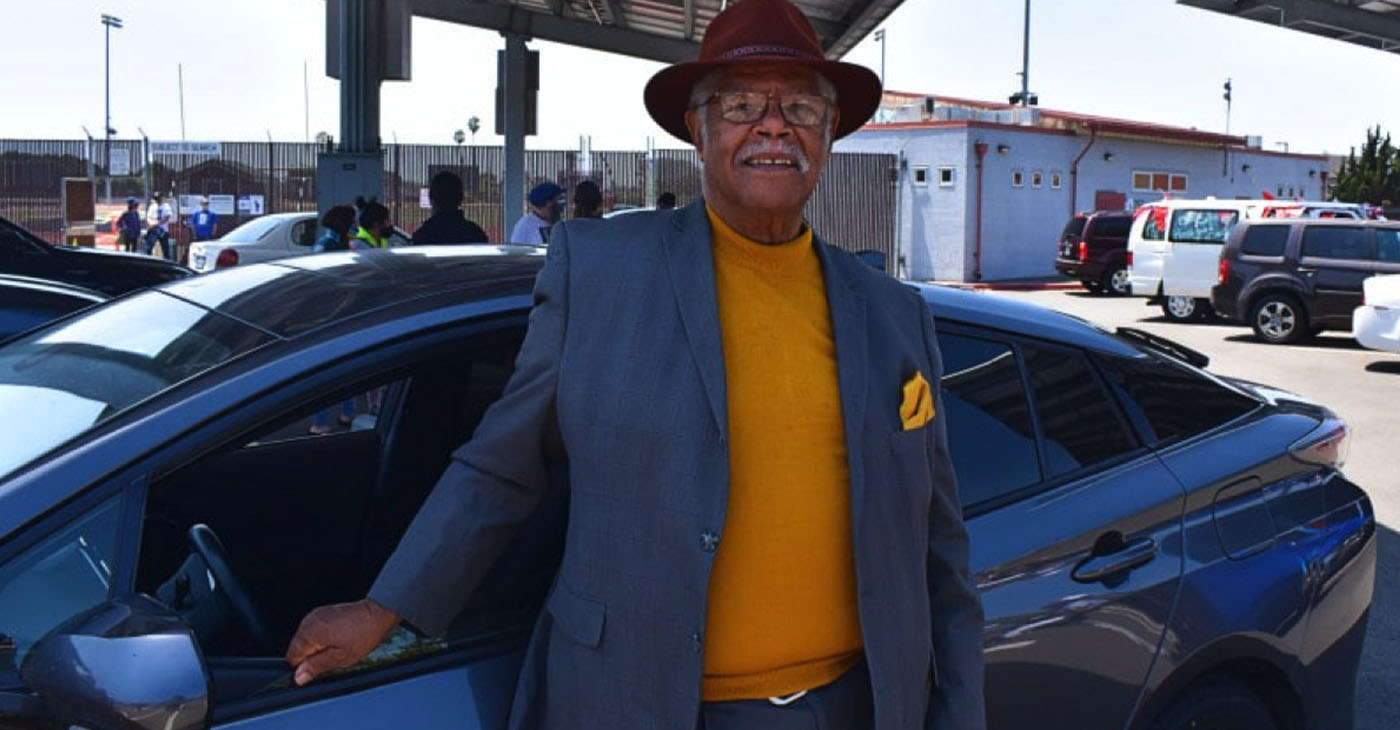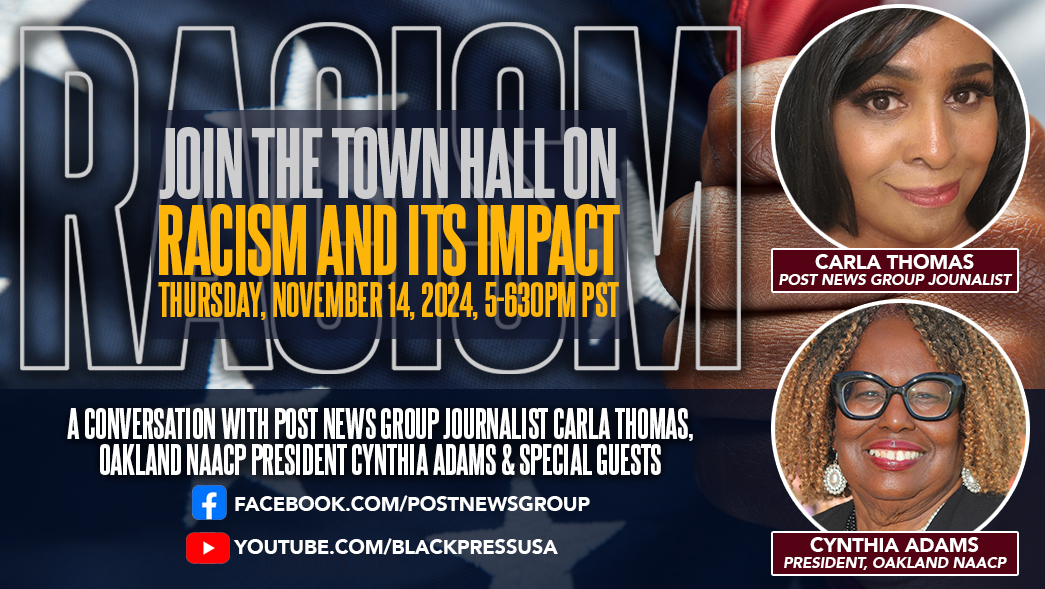Bay Area
Nat Bates, First Elected to Richmond Council in 1967, Bids ‘Final Farewell’
After serving this great City of Richmond twice as its mayor, several times as vice mayor, and many years as a councilmember since 1967, this day has very special meaning to me as I emotionally bid my final farewell.

By Nat Bates
(Former Richmond City Councilmember Nat Bates, who at age 91 was the nation’s oldest elected official, penned this farewell speech for his final day in office Jan. 10, 2023.)
After serving this great City of Richmond twice as its mayor, several times as vice mayor, and many years as a councilmember since 1967, this day has very special meaning to me as I emotionally bid my final farewell.
Because of this historical Covid-19 pandemic swearing-in ceremony, I will try to be brief with my final statements as an elected official.
In 1967, when elected on my very first attempt as a city councilman, little did I realize the length of my tenure nor the many contributions I would be involved in making Richmond such a prosperous and quality city.
If I were to qualify my strongest commitments and contributions to the city and community, I would list in no preferable order my solid support for Public Safety, perhaps because of my 30+ years as an Alameda County Probation Officer.
Throughout this nation and universe, public safety of all residents is the number one priority the citizens demand from our government.
Second, no city can survive without a strong business community that includes all of our businesses (small, medium and large) because they contribute immensely to city employment opportunities for our residents, and significant and much needed tax revenue to the City.
I am very proud to have provided leadership roles in the development of the Hilltop Mall Shopping Center, which also included the Auto Row, which at the time, was one of the development showcases of the Bay Area negotiations in attracting Home Depot, Target, Foodco, Costco and other businesses that were frequently met with strong opposition — but the majority of the council stood firm and strong while approving these projects for the betterment of the city.
I am also very proud of my personal working relationships with almost every housing developer including the late Carl Dame (Carriage Hills), Bert Clausen (Brickyard Cove), along with Peterson/Moratti, Former Oakland A’s owner Steve Schott, the Ghilemetti Builders, Toll Brothers, Shea Homes, and the late Robert Poe and his son Richard (Marina Bay to name a few), for the high quality of beautiful housing developments that has made Richmond one of the most desirable places in the Bay Area to reside.
These developments have brought to Richmond a strong group of talented citizens who have contributed significantly to the city by becoming city staff members and or participating on our boards and commissions.
Needless to say, many of these business and housing developments oftentimes have received strong opposition from various members of the community, but we proceeded to move forward, and the city is richer and more prosperous than ever.
Additionally, I wish to thank the voters for their continued support over the years where it afforded me a personal opportunity to meet and work directly with several United States presidents, governors, United States senators, members of Congress and others.
Obviously, one of the highlights of my career was working personally with President Jimmy Carter and his administration in the construction of the John Knox Freeway.
Being the one and only City of Richmond elected official to have been invited to a White House Christmas Celebration by then President Barack and First Lady Michelle Obama and personally meeting and communicating with them became the highlight of my political career. This occurred only because of the continued support of the voters, and I thank each of them very much.
Time does not permit me to mention all of those who have assisted me on the way, but I would like to acknowledge City Manager Shasa Curl, City Clerk Pamela Christian, Planning Director Lina Velasco, Community Services Director LaShonda White, Police Chief Bisa French, Fire Chief Angel Montoya, Housing Director Nannette Bechman, IT Director Sue Hartman, City Attorney Dave Aleshire and their entire staffs along with City Council Liaison Trina Jackson-Lincoln and several others — too many to name.
Staff plays such an important role while supporting elected officials in accomplishing their goals and aspirations, and Richmond has some of the best.
I would be derelict — as well as disrespectful — if I did not acknowledge the many who contributed to this five decades of political journey. First was my 1967 campaign committee where many are no longer with us including my late spouse Shirley Bates, the late Mayor George Livingston, a personal friend, along with then Supervisor Jim Kinney; businessman Elton Brombacher; Aileen Hernandez, perhaps the most intelligent and savvy political person I have known who was later elected to NOW (the National Organization of Women); longtime friend Louis Pierce; and Winters Calvin.
Very pleased to continue to have with us committee members are former Councilman Jim McMillan, Meckila Pierce and Willie Reed who has been my sports teammate from El Cerrito High School, Contra Costa College, and the Indian Head Rockets baseball team where the two of us were recently honored by being inducted into the Saskatchewan Canadian Baseball Hall of Fame this past August 2022.
I would also like to thank the many mom-and-pop, small and big business groups I have worked with over the years as well as the Richmond Chamber of Commerce, led by James Lee; Council of Richmond Industries, led by Katrinka Ruk; and the Contra Costa Realtors and Apartment Association. Also, many thanks to the labor unions, especially the Contra Costa Building and Construction Trades Council with Bill Whitney, Ché Timmons, Tom Hanson, Don Gosney, and Richmond’s Public Safety — Police and Fire Unions for their years of support.
Thanks to individual friends like Al Engel, Jim Levin, David Spatz, Bobbie Amos, Terry Kwong, Barbara O’Neil, Shawn Molberg, Steve Seher, and the Lompa Family, to name a few.
Lastly, to my devoted and loving family who has been with me each and every step of the way through the good and bad times. My only daughter Gale Bates Anderson, my eldest son Larry Nathaniel Bates, my youngest son Steven Bates as well as their spouses, in-laws, my grand- and great-grandchildren. I owe each of them my appreciation because my journey has also been their journey, and I love them very much.
To incoming Mayor Martinez and the new council, I wish you the very best in solving the many challenges you will be facing immediately and in the future. A city divided serves no purpose for our residents, and please be mindful the business community and their taxes are the life stream of a prosperous and successful city.
There must be some respectful resolution to Measure “U” which is creating and causing havoc in our business community. Remember, as Richmond prospers, we all prosper and as Richmond fails, we collectively also fail.
Finally, to my many loyal friends and supporters, Thanks again for five wonderful and memorable decades filled with love, respect, support and appreciation. We did it together, and I could not have done it without you.
Stay healthy and safe and may God continue to bless each of us and this great city of Richmond, the only home I know and love.
Activism
An Inside Look into How San Francisco Analyzes Homeless Encampments
Dozens of unhoused people are camped at Sixth and Jesse streets in San Francisco’s South of Market neighborhood. Tents made of tarps and blankets, piles of debris, and people lounging alongside the allies and walls of businesses are seen from all angles. These are some of the city’s hotspots. City crews have cleared encampments there over 30 times in the past year, but unhoused people always return.

By Magaly Muñoz
Dozens of unhoused people are camped at Sixth and Jesse streets in San Francisco’s South of Market neighborhood. Tents made of tarps and blankets, piles of debris, and people lounging alongside the allies and walls of businesses are seen from all angles.
These are some of the city’s hotspots. City crews have cleared encampments there over 30 times in the past year, but unhoused people always return.
But it’s normal to have tents set up again within less than 24 hours after an encampment sweep, David Nakanishi, Healthy Streets Operation Center Manager at the Department of Emergency Management, says. Sometimes there’s less people than before but often there is also no change.
“Most of the people that were in the encampments that want to go inside, we’ve gotten the majority of those [into shelter],” Nakanishi says. “Many of the people we encounter now, are those who have various reasons to not accept shelter, and some are already in shelter/housing”.
Since the ruling of Grants Pass by the US Supreme Court earlier this summer, which allows cities the authority to ban people from camping or sleeping on the streets, San Francisco has been at the head of the conversation to crack down on encampments.
Where neighboring cities in the Bay Area are clearing encampments a few days a week, San Francisco is sweeping 10 times a week, two per weekday.

David Nakanishi, Healthy Streets Operation Center Manager at the San Francisco Department of Emergency Management, makes a 311 report on an encampment in the Mission District. These reports allow smaller city teams to tackle individual spots where unhoused people frequent. Photo by Magaly Muñoz.
Considering the controversy that plagues the city around its harsh policies, the Post decided to tag along on a ride with Nakanishi to show us how he decides what encampments make it on the city’s sweep list.
Nakanishi, having over 20 years of experience in homelessness management, drives around the busiest parts of the city almost daily. He’s tasked with arranging a weekly sweeping operation schedule for city teams to engage with unhoused folks to help get them off the streets.
So what exactly is he looking out for when deciding what encampments get swept?
It depends, he says.
Locations like schools, recreational centers, senior centers, or businesses are places he tends to want to address quickly, especially schools. These are the places where the complaints are highest and access to facilities is important for residents.
He says he also takes into account 311 calls and reports made to him by city staff. On the date of publication, over 100 calls and reports were made about encampments around the city, according to San Francisco data.

Makeshift structures built from plywood and tarps are starting to pop up more throughout the city. Certain areas under freeways are not under direct authority from San Francisco, making it harder to sweep these encampments. Photo by Magaly Muñoz.
Nakanishi made a few 311 reports himself on the ride along, pulling over to take photos and describe the encampments into his 311 app. He says it helps him remember where to possibly sweep next or allows smaller teams in the city to engage quicker with individuals on the streets.
Nakanishi also looks at the state of the encampments. Are there a lot of bulky items, such as furniture, or makeshift structures built out of tarps and plywood, blocking areas of traffic? Is trash beginning to pile up and spill into the streets or sidewalks? Sites that meet this criteria tend to be contenders for encampment sweeps, Nakanishi says.
Street by street, he points out individuals he’s interacted with, describing their conditions, habits, and reasons for denying assistance from the city.
One man on 2nd St and Mission, who rolls around a blue recycling bin and often yells at passing pedestrians, has refused shelter several times, Nakanishi says.
People deny shelter for all kinds of reasons, he says. There’s too many rules to follow, people feel unsafe in congregate or shared shelters, or their behavioral and mental health problems make it hard to get them into proper services.

Inside a tent left by an unhoused man on Stevenson and 14th Street in San Francisco. The area smelled of human waste and leftover alcohol. Photo by Magaly Muñoz.
Nakanishi references another man on South Van Ness under the freeway, who city outreach have attempted to get into shelter, but his screaming outbursts make it difficult to place him without disturbing other people in the same space. Nakanishi says it might be an issue of the man needing resources like medication to alleviate his distress that causes the screaming, but the city behavioral team is in the process of outreaching him to figure that out.
In October, city outreach teams engaged with 495 unhoused people. 377 of those engaged refused shelter and only 118 accepted placements, according to city data. That number of monthly referrals is consistent throughout the entirety of 2024 so far.
Nakanishi has long advocated for the well-being of unhoused people, he explains. In 2004, he was working with the Department of Public Health and told then-Mayor Gavin Newsom that there needed to be more housing for families. Nakinishi was told it was easier to deal with individuals first and the city “will get there eventually.” 20 years later, family housing is still not as extensive as it could be, and the waiting list to get placements for families is a mile long with over 500 names.
In 2020, he was a Senior Behavioral Health Clinician at a hotel in the city during the pandemic. He says in 2021 he collaborated with DPH to provide vaccines to those staying in the makeshift hotel shelters once those became available.

Nakanishi strips apart a solo tent on Stevenson and 14th Street in San Francisco. He discards items, like tarps and cardboard, so that people cannot reuse them to make another sleeping structure. Photo by Magaly Muñoz.
Despite the constant media attention that city outreach is inhumanely treating homeless people, so much so that it has led to lawsuits against San Francisco from advocates, Nakanishi says not a lot of people are seeing the true conditions of some encampments.
He describes soiled clothing and tents, drenched in urine, and oftentimes rodents or bug infestations in places where people are sleeping. He’s asked homeless advocates- often those who are the most critical about the city’s work- who have shown up to observe the sweeps if those are conditions the city should allow people to be subjected to, but not many have answers for him, Nakanishi says.
The city’s “bag and tag” policy allows city workers to throw away items that are “soiled by infectious materials” such as bodily fluids and waste.
Sweep operations are conducted at 8am and 1pm Monday through Friday. People at the encampments are given 72 hour notice to vacate, but some don’t leave the area until the day of the sweep.
City outreach workers come out the day before and day of to offer resources and shelter to those interested. The Department of Public Works discards any trash that is left over from the sweep and washes down the area.
Nakanishi told the Post that the only time the city takes tents or personal possessions from residents is when folks become physically violent towards workers and police take the items as evidence. Other items taken are bagged and tagged in accordance with city policy.
Stories from local newspapers such as the San Francisco Standard and the Chronicle show instances of SFPD handcuffing residents while their items are thrown in the trash or disposing of personal possessions without reason.
Advocates have long been pushing for a more competent and compassionate process if the city is going to choose to continue sweeping unhouse people.
No matter the lawsuits and constant criticisms from allies, the encampment sweeps are not slowing down, even with the cold weather quickly approaching the coastal city.
Nakanishi says there aren’t a lot of large encampments left in San Francisco so now they do runs of streets in order to stretch out the sweeps as much as possible.
It’s calculated strategies and years of first hand knowledge that make this job work, “It takes dedication to the work, caring for the people and the community, and persistence, patience and sometimes good luck to make the positive changes for the people on the street,” Nakanishi says.
Activism
Oakland Post: Week of November 13 – 19, 2024
The printed Weekly Edition of the Oakland Post: Week of November 13 – 19, 2024

To enlarge your view of this issue, use the slider, magnifying glass icon or full page icon in the lower right corner of the browser window. ![]()
Activism
LIVE! — TOWN HALL ON RACISM AND ITS IMPACT — THURS. 11.14.24 5PM PST
Join us for a LIVE Virtual Town Hall on the Impact of Racism hosted by Post News Group Journalist Carla Thomas and featuring Oakland, CA NAACP President Cynthia Adams & other Special Guests.
Thursday, November 14, 2024, 5 p.m. – 6:30 p.m. PST

Join us for a LIVE Virtual Town Hall on the Impact of Racism hosted by Post News Group Journalist Carla Thomas and featuring Oakland, CA NAACP President Cynthia Adams & other Special Guests.
Thursday, November 14, 2024
5 p.m. – 6:30 p.m. PST
Discussion Topics:
• Since the pandemic, what battles have the NAACP fought nationally, and how have they impacted us locally?
• What trends are you seeing concerning Racism? Is it more covert or overt?
• What are the top 5 issues resulting from racism in our communities?
• How do racial and other types of discrimination impact local communities?
• What are the most effective ways our community can combat racism and hate?
Your questions and comments will be shared LIVE with the moderators and viewers during the broadcast.
STREAMED LIVE!
FACEBOOK: facebook.com/PostNewsGroup
YOUTUBE: youtube.com/blackpressusatv
X: twitter.com/blackpressusa
-

 Alameda County3 weeks ago
Alameda County3 weeks agoAlameda County District Attorney Pamela Price Announces $7.5 Million Settlement Agreement with Walmart
-

 Activism3 weeks ago
Activism3 weeks ago‘Jim Crow Was and Remains Real in Alameda County (and) It Is What We Are Challenging and Trying to Fix Every Day,’ Says D.A. Pamela Price
-

 Bay Area3 weeks ago
Bay Area3 weeks agoIn the City Attorney Race, Ryan Richardson Is Better for Oakland
-

 Activism3 weeks ago
Activism3 weeks agoOakland Post: Week of October 30 – November 5, 2024
-

 Alameda County2 weeks ago
Alameda County2 weeks agoD.A. Price Charges Coliseum Flea Market Vendors in Organized Retail Theft Case
-

 Activism3 weeks ago
Activism3 weeks ago‘Criminal Justice Reform Is the Signature Civil Rights Issue of Our Time,’ says D.A. Pamela Price
-

 Activism3 weeks ago
Activism3 weeks ago“Two things can be true at once.” An Afro-Latina Voter Weighs in on Identity and Politics
-

 Arts and Culture3 weeks ago
Arts and Culture3 weeks agoMacArthur Fellow Jericho Brown’s Poetry Reflects Contemporary Culture and Identity
















































